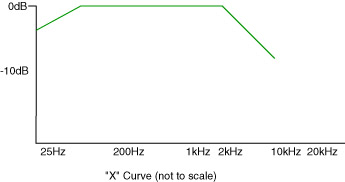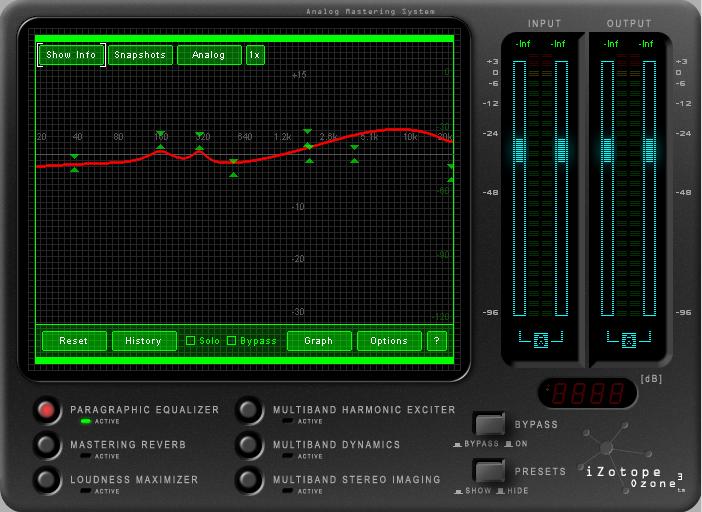I converted a DTS theater disc to 5.1 dts to experiment with and was wondering what the difference in the dynamic ranges are from theater to home. i noticed that playing the new 5.1 dts track sounds a little flat and not very loud when converted to 5.1 dts (for home). what would be the ideal adjustments to make with an equalizer (using goldwave?) to calibrate the track for home theater use? what frequencies am i looking to raise and lower etc etc so it can sound presentable? i tried one adjustment but the trebles and higher frequencies (1khz-15khz) were way too loud. i can keep fooling around with it until i get it right but that would take longer than if i knew what frequencies to adjust and to what volumes.
+ Reply to Thread
Results 1 to 20 of 20
-
-
the conversion process alone - since it has to uncompressed and re-compressed, loses information ..
DTS theater disks are set to what is known as a theater curve - look that up (i'm not going to get into to much detail here as much detail can be found on the web) , but basically the HF are rolled off by design ..
loudness and dynamic range are two very different things ...
all the info you asked is on the DTS web site ....
A DTS theater disk is 5.1 DTS (well it also can be more) -- do you mean a disk that was meant to be played on a DTS-6AD in a movie theater is what you have ? Or DTS from a DVD ?
They are compressed completely different -- I know - since I do the theater mixs/disks and have done mixs also for dvd .."Each problem that I solved became a rule which served afterwards to solve other problems." - Rene Descartes (1596-1650) -
it is a 5.1 theater disc used for the movie soundtrack in the theater (not a home dvd). i converted the 5 channels to 5 mono wavs (changing them to 48khz) and then to 5.1 dts.
i fooled around with the EQ a little more and got it sounding great (in comparison to it's dolby counterpart on the official dvd) but then the subwoofer channel wasn't very active. if i can get that sounding good, it would be a great custom mix.
i understand that doing this isn't the way to go for making a dts track but it's all i've got on the movie and want to see how far i can take it.
do you have any advice in compiling the lfe channel from 5 wavs? i mixed all 5 channels in to one mono and then using goldwave i changed the low/highpass filter making the intial cutoff 20hz and the final cutoff 120hz and then used that as my lfe channel. the bass lacked the "punch", if you will but was deep. i don't have the dts lfe disc (if i understand correctly, dts uses a seperate disc for the lfe channel?) so i'm trying to see how good i can make one with what i've got. -
the , what you call, the subwoofer channel is the effects channel ... LF is mixed into all the channels also (there are two types of DTS theater playback machines though - 1 plays all 6 channels discreet and full range - the other does not ... the disks can not be switched) ...
the punch is not in the LFE channel -- its in the main channels LFR , that why theaters use horn loaded (often) 15" in the mid bass ..
the LFE channel is almost not even heard but felt ... you need a large room and lots of volume and 18" drivers (what it was mixed for) ..
DTS does NOT ever use a seperate disk for LFE , its on the disk you have, most of it is matrixed into the surrounds .."Each problem that I solved became a rule which served afterwards to solve other problems." - Rene Descartes (1596-1650) -
damn. i wish i worked with dts!!!!!

well, if you had a dts theater disc and wanted to tweak it for dvd use (not that you would or anything) what would YOU do to it?
you're the only person i've ever come across that would be able to know how to do this right (if there is a right way). -
this is a graph of how the audio is eq'd now roughly ...

you will want to reverse this (to a point - otherwise it will sound to bright) - so starting at 2k , you would boost 3 dB/octave to 8k and level off (for a typical small home theater)
you will want to insert small boosts at 80 and 160Hz and maybe 320Hz
it will look like this (to add - not the final response - this is what you would add) when done basically, which i just did as an example on a paragraphic eq:
 "Each problem that I solved became a rule which served afterwards to solve other problems." - Rene Descartes (1596-1650)
"Each problem that I solved became a rule which served afterwards to solve other problems." - Rene Descartes (1596-1650) -
!!! whoa! i didn't think you'd respond to that. you've been a great help!
can i perform the adjustments with goldwave? i would be working with each mono file individually, correct? and then mux them together to get the final dts? or do i just throw in the dts file and edit that?
is there a freeware version of the program you used for trial? if not, what else would you recommend? -
you can do it with goldwave
the program i used is a plug in for pro-tools or vegas or any(RTAS/AudioSuite/HTDM), VST, MAS, Audio Unit, and DirectX program
http://www.izotope.com/products/audio/ozone/"Each problem that I solved became a rule which served afterwards to solve other problems." - Rene Descartes (1596-1650) -
ok cool so i'm going to go ahead and use the izotope program.
so i do the tweaks to each individual mono file? also, would it be a good idea to perform a volume normalize on each file so they all match up or should they already have been normalized from the disc? it already sounds good so far on the sytem, volume wise. nothings too loud or low or anything.
also, what do i do about the lfe channel? do i just leave it a blank file and author to 5.1 dts and let my system do all the low frequency extracting? -
do what you did before , mix all the channels , and do a low pass filter @ 120khz , 18 dB/octave
"Each problem that I solved became a rule which served afterwards to solve other problems." - Rene Descartes (1596-1650) -
18 db/octave? you mean raise the channel 18 db?
sorry i'm not too good with the technical stuff... -
means in simple terms a sharp cut off at the crossover point
"Each problem that I solved became a rule which served afterwards to solve other problems." - Rene Descartes (1596-1650) -
Reading this thread with a smile

Analogy is trying to adapt a Ferrari V12 engine control chip to a Honda Civic.
The theater DTS encode will be compressed (for S/N reasons) and targeted to the hardware EQ profiles found in theater hardware. This has nothing to do with your playback hardware unless you got a good deal on ebay. -
Originally Posted by edDV
this is not the case ..... i am just showing how the dts theater disk was eq'd and the conversion for home theater ..
not really sure what you mean ... in fact ...
i make the bloody things (for theaters) , so do know a thing or two about them
i also know that the whole thing in converting them is a fairly pointless exercise except as a mater of curiosity ....."Each problem that I solved became a rule which served afterwards to solve other problems." - Rene Descartes (1596-1650) -
My comment was more to kaotek. Your last sentence reflected my thoughts.Originally Posted by BJ_M
There is little need to reverse engineer and convert these EQ curves when it is all documented in the DTS theater equipment standards. The conversions have already been done for Home DVD and CD discs that contain DTS.
As an exercise it is interesting to postulate having found a theater disc on the sidewalk and desiring to reverse engineer it. But the more direct way to learn is to read the DTS standards and application notes.
Here are some start links.
http://www.film-tech.com/warehouse/manuals/DTSSTUDIOMIX.pdf
http://www.surroundmusic.net/articles/dtsco3.html
http://www.dtsonline.com/media/uploads/pdfs/DVD_Authoring.pdf
http://www.real-image.com/dts/abtdts.asp
http://www.real-image.com/dts/film.asp
http://www.real-image.com/dts/120402.asp
http://64.233.179.104/search?q=cache:fsk9bm91BEIJ:www.mp3-tech.org/programmer/docs/dts...ient=firefox-a
The future of multiplex cinema
http://www.real-image.com/digital/diginews/070301.asp
http://www.thx.com/mod/techlib/receivers.html -
BJ_M - I took the 5 wav files and made the adjustments. You're saying it's a pointless exercise, and I'm not questioning your credibility at all or your knowledge about this. You obviously know more than enough, considering your occupation, but when I made the adjustments you recommended, this home-brewed DTS mix sounded better than the official Dolby one on the DVD. I'm not making this up at all or trying to fool anyone. All I did was take the wavs and adjust the EQ paramaters. What is wrong with that? It may not be completely professional, but what if it still sounds good? I made comparisons with the Dolby counterpart and it sounds much more natural, deeper, and the sound field seems wider. This is what I want.
My only problems left are the low frequencies. The LFE channel has too much bass. It's pounding LFE everywhere instead of to the deepest ones that should be heard so when I play a demo there is a constant blare of bass. is there a way to just tell Goldwave that I want to get rid of all frequencies above 80Hz? Or something? What can I change to make this sound better? -
that it sound good is all that counts ..
pounding bass is often not at the lowest freq. but really much higher up .... LFE , as i instructed above, it crossed over at 120 ..
you can just reduce the level of the LFE and also remove those 2 'bumps' at 80 and 160hz and make them dips of 2 and 4db respectively ..
you might also want to cut off the lfe at the bottom end at 40hz -- with a 12dB per oct. slope"Each problem that I solved became a rule which served afterwards to solve other problems." - Rene Descartes (1596-1650)
Similar Threads
-
AC3 - figure out dynamic range compression (DRC)
By Lariel in forum AudioReplies: 9Last Post: 4th Apr 2013, 14:09 -
Any s/w to reduce audio dynamic range in DVD files WITHOUT demuxing first?
By EmmB in forum Newbie / General discussionsReplies: 1Last Post: 13th Sep 2011, 16:22 -
Creating a Blu-ray Theater Demo Disc w/ DTS-HD, TrueHD & LPCM
By scubasteve2365 in forum Authoring (Blu-ray)Replies: 6Last Post: 29th Jan 2011, 11:00 -
Dynamic range compression in Mencoder
By viperx116 in forum Newbie / General discussionsReplies: 2Last Post: 26th Dec 2009, 22:02 -
Batch Dynamic Range Compressing and Normalising audio for video files?
By dahouse in forum AudioReplies: 4Last Post: 15th May 2008, 17:30




 Quote
Quote